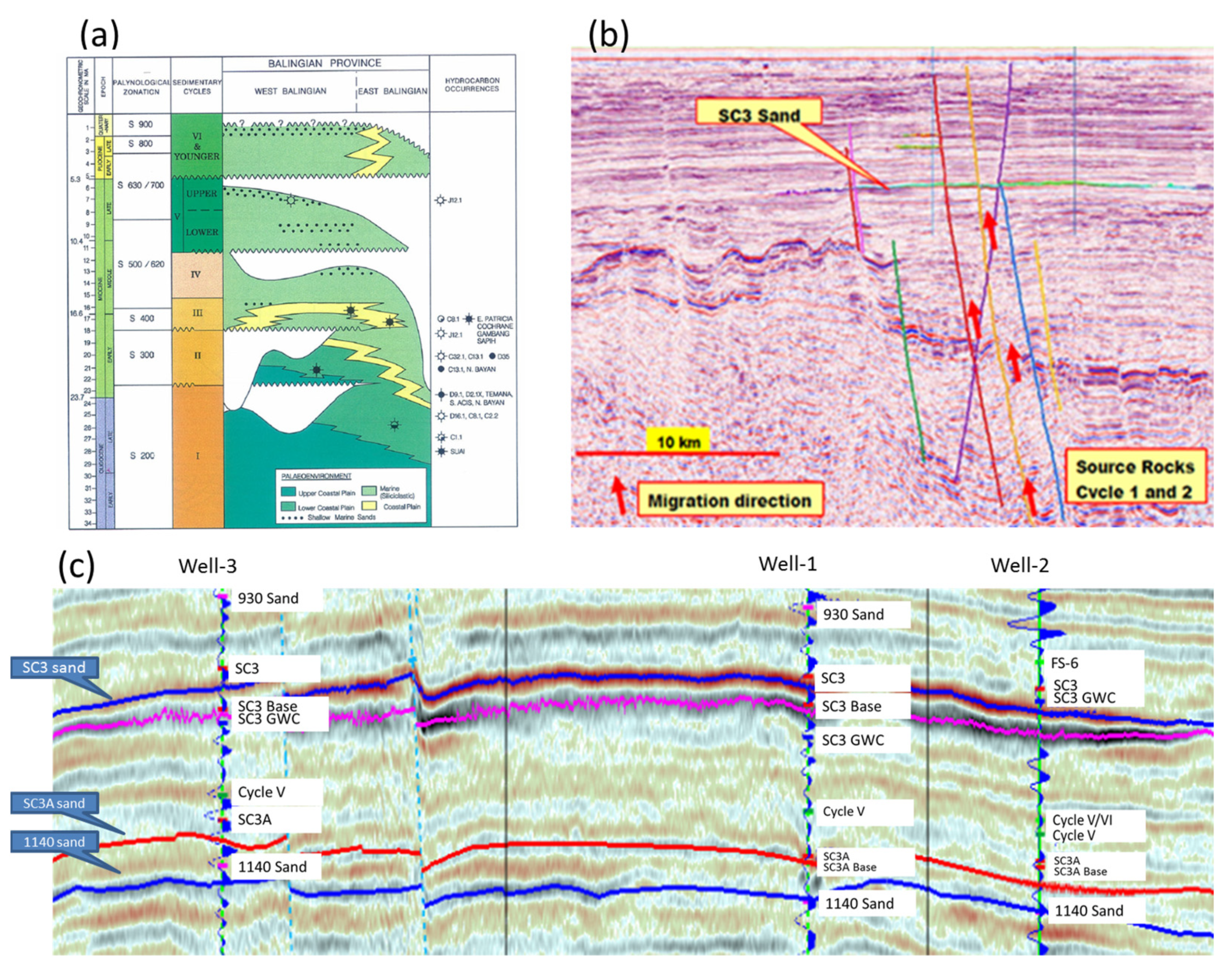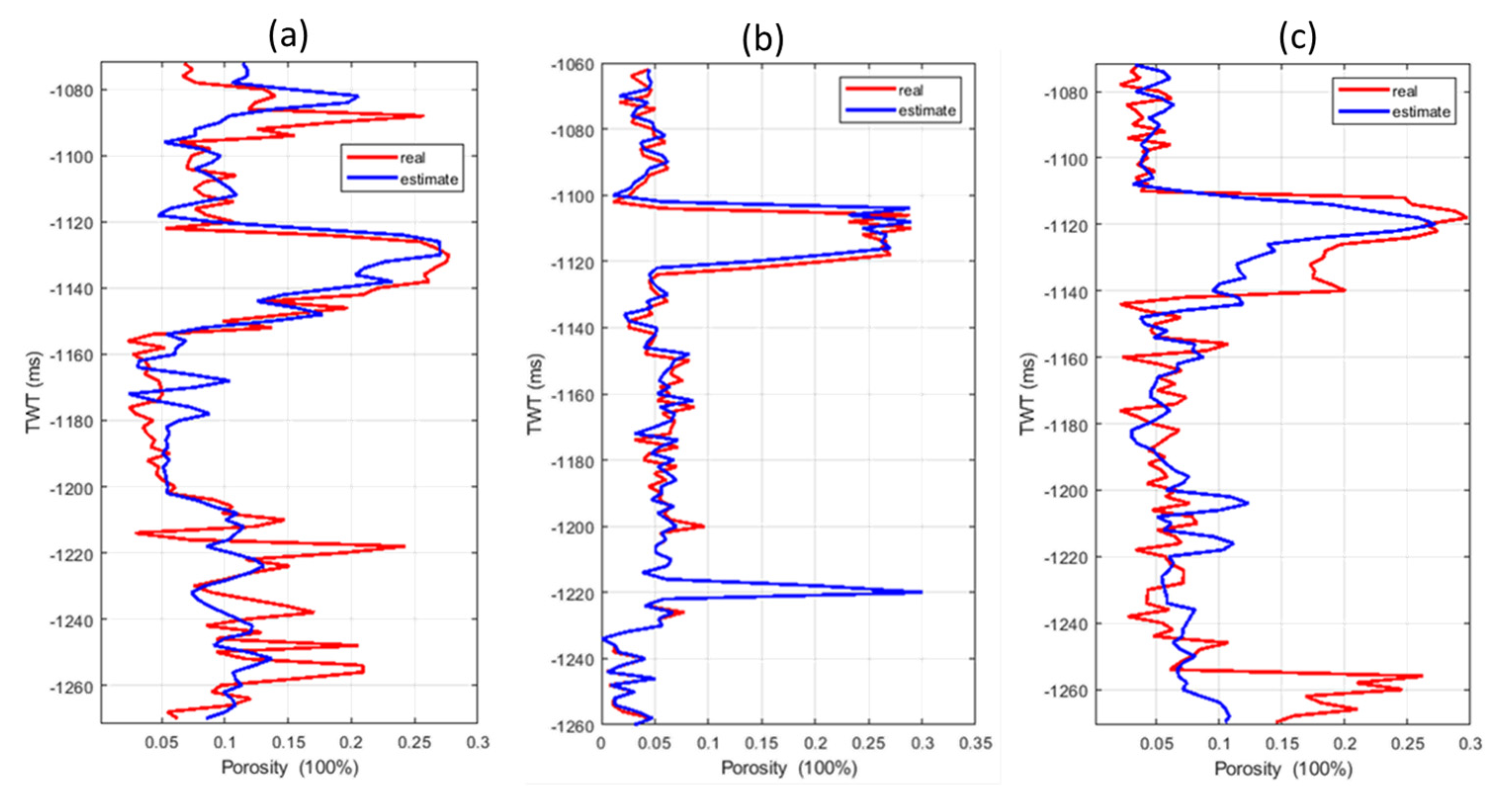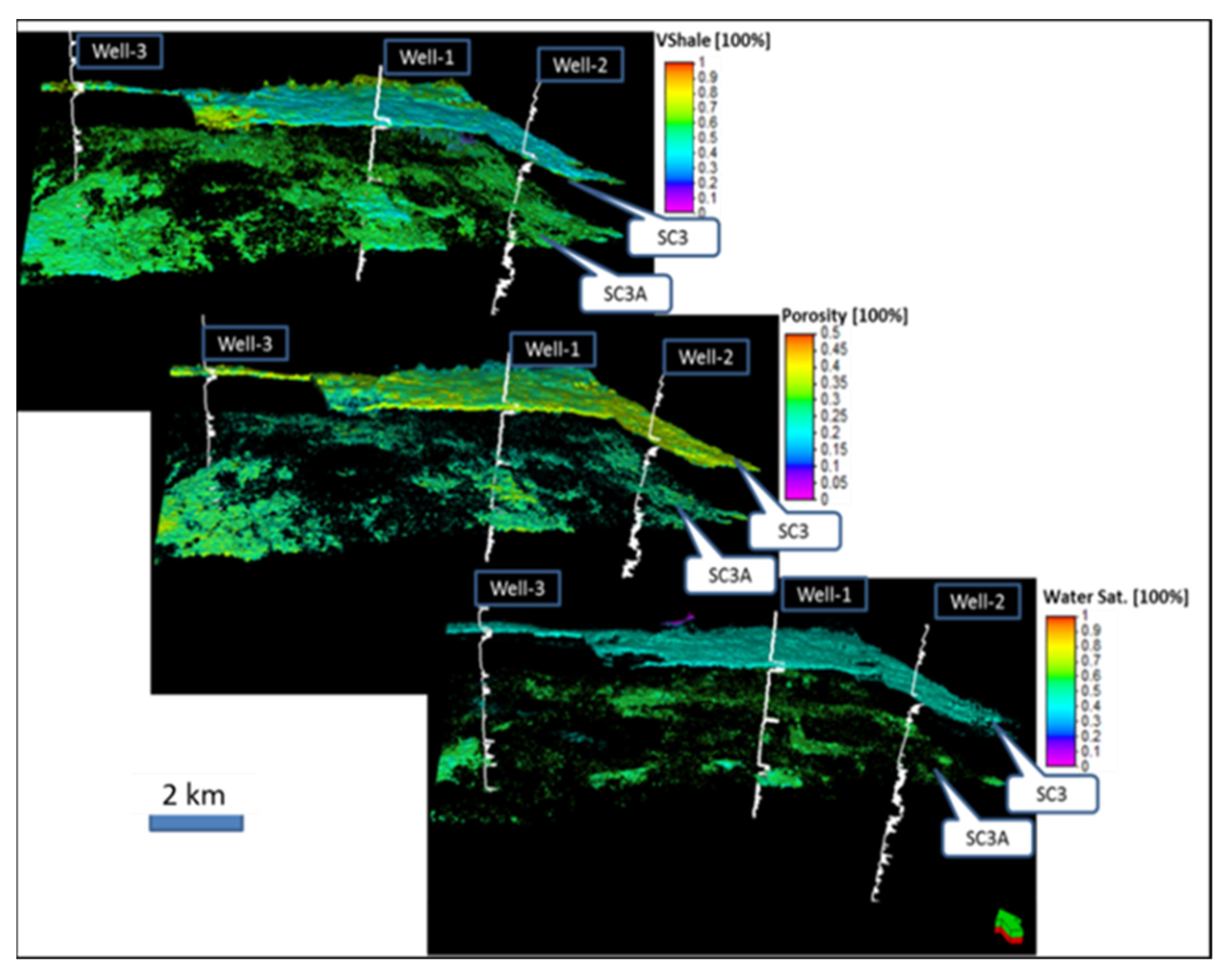Predicting Reservoir Petrophysical Geobodies from Seismic Data Using Enhanced Extended Elastic Impedance Inversion
Abstract
1. Introduction
2. Data and Methods
2.1. Data
2.1.1. Study Field Geological Setting
2.1.2. Study Field Petroleum System
2.1.3. Data for Inversion
2.2. Methodology
2.2.1. Extended Elastic Impedance (EEI) Inversion
2.2.2. Stochastic Process
2.2.3. Neural Network Modelling
2.2.4. Petrophysical Prediction
2.2.5. Geobody Generation
3. Results
3.1. EEI Petrophysic Optimum χ Angle
3.2. Stochastic Petrophysical EEI Model Enhancement
3.3. GRNN Model
3.4. Porosity Prediction
3.4.1. Well-1 Site Porosity Prediction
3.4.2. Inversion Result Validation
3.5. Water Saturation and Volume of Shale Prediction
4. Discussion
4.1. Spatial Geology Model
4.1.1. Geobody Extraction and Interpretation
4.1.2. Potential Benefit
5. Conclusions
Author Contributions
Funding
Data Availability Statement
Acknowledgments
Conflicts of Interest
Nomenclature
| 1D | =one dimensional |
| 3D | =three dimensional |
| χ | =chi (AVO rotation angle) |
| σ | =sigma (smoothing factor for GRNN) |
| AI | =acoustic impedance |
| AVA | =amplitude versus angle |
| AVAz | =amplitude versus azimuthal |
| AVO | =amplitude versus offset |
| CCUS | =carbon capture utilization and storage |
| CO2 | =carbon dioxide |
| CSSI | =constrained sparse spike inversion |
| =distance between sample in GRNN modeling | |
| E-W | =east to west direction |
| EEI | =extended elastic impedance |
| =extended elastic impedance matrix | |
| =posterior extended elastic impedance matrix | |
| =prior extended elastic impedance matrix | |
| EI | =elastic impedance |
| EGR | =enhanced gas recovery |
| EOR | =enhanced oil recovery |
| GRNN | =generalized regression neural network |
| GI | =gradient impedance |
| GWC | =Gas Water Contact |
| MCMC | =Markov Chain Monte Carlo |
| NW-SE | =northwest to southeast direction |
| P | =GRNN training input vectors |
| P′ | =GRNN new input vector for testing or prediction |
| =posterior EEI probability function | |
| =real (observed) petrophysical log | |
| =predicted petrophysical properties | |
| =predicted petrophysical properties for given posterior EEI | |
| SC3 | =thick (major) gas reservoir name in the studied field |
| SC3A | =thin gas reservoir name in the studied field |
| TVD | =true vertical depth |
| TWT | =two way travel time |
| T | =target vectors for GRNN training |
| T′ | =predicted vectors resulted by GRNN test (prediction) |
| Vp/Vs | =ration of compressional and shear velocity |
| VTI/HTI | =vertical transverse isotropy/horizontal transverse isotropy |
References
- Saadu, Y.K.; Nwankwo, C.N. Petrophysical evaluation and volumetric estimation within Central swamp depobelt, Niger Delta, using 3-D seismic and well logs. Egypt. J. Pet. 2018, 27, 531–539. [Google Scholar] [CrossRef]
- Fajana, O.P. 3-D static modelling of lateral heterogeneity using geostatistics and artificial neural network in reservoir characterisation of “P” field, Niger Delta. NRIAG J. Astron. Geophys. 2020, 9, 129–154. [Google Scholar] [CrossRef]
- Roden, R. Seismic Inversion Overview; DHI Consortium: Houston, TX, USA, 2011. [Google Scholar]
- Anees, A.; Zhang, H.; Ashraf, U.; Wang, R.; Thanh, H.V.; Radwan, A.E.; Ullah, J.; Abbasi, G.R.; Iqbal, I.; Ali, N.; et al. Sand-ratio distribution in an unconventional tight sandstone reservoir of Hangjinqi area, Ordos Basin: Acoustic impedance inversion-based reservoir quality prediction. Front. Earth Sci. 2022, 10, 1018105. [Google Scholar] [CrossRef]
- Ashraf, U.; Zhang, H.; Anees, A.; Ali, M.; Zhang, X.; Abbasi, S.S.; Mangi, H.N. Controls on reservoir heterogeneity of a shallow-marine reservoir in Sawan Gas Field, SE Pakistan: Implications for reservoir quality prediction using acoustic impedance inversion. Water 2020, 12, 2972. [Google Scholar] [CrossRef]
- Russel, B. Seismic Reservoir Characterization and Pre-stack Inversion in Resource Shale Plays. In Proceedings of the Geoscience Technology Workshop, Permian and Midland Basin New Technologies, Houston, TX, USA, 4–5 September 2014. [Google Scholar]
- Li, L.; Zhang, J.J.; Pan, X.P.; Zhang, G.Z. Azimuthal elastic impedance-based Fourier coefficient variation with angle inversion for fracture weakness. Pet. Sci. 2020, 17, 86–104. [Google Scholar] [CrossRef]
- Adesanya, O.Y.; Adeoti, L.; Oyedele, K.F.; Afinotan, I.P.; Oyeniran, T.; Alli, S. Hydrocarbon reservoir delineation using simultaneous and elastic impedance inversions in a Niger Delta field. J. Pet. Explor. Prod. Technol. 2021, 11, 2891–2904. [Google Scholar] [CrossRef]
- Whitcombe, D.N.; Connolly, P.A.; Reagan, R.L.; Redshaw, T.C. Extended elastic impedance for fluid and lithology prediction. Geophysics 2002, 67, 63–67. [Google Scholar] [CrossRef]
- Sharifi, J.; Moghaddas, N.H.; Lashkaripour, G.R.; Javaherian, A.; Mirzakhanian, M. Application of extended elastic impedance in seismic geomechanics. Geophysics 2019, 84, R429–R446. [Google Scholar] [CrossRef]
- Aleardi, M. Estimating petrophysical reservoir properties through extended elastic impedance inversion: Applications to off-shore and on-shore reflection seismic data. J. Geophys. Eng. 2018, 15, 2079–2090. [Google Scholar] [CrossRef]
- Sandal, S.T. The Geology and Hydrocarbon Resources of Negara Brunei Darussalam; Brunei Shell Petroleum Company: JalanUtara, Panaga, 1996; pp. 230–243. [Google Scholar]
- Madon, M.; Abolins, P. Balingian Provinces: In the Petroleum Geology and Resources of Malaysia; PETRONAS: Kuala Lumpur, Malaysia, 1999; pp. 344–367. [Google Scholar]
- Connolly, P.A. Elastic impedance. Lead. Edge 1999, 18, 438–452. [Google Scholar] [CrossRef]
- Avseth, P.; Mukerji, T.; Mavko, G. Quantitative Seismic Interpretation: Applying Rock Physics Tools to Reduce Interpretation Risk; Cambridge University Press: Cambridge, UK, 2010. [Google Scholar]
- Hampson, D.P.; Russell, B.H.; Bankhead, B. Simultaneous inversion of pre-stack seismic data. In SEG Technical Program Expanded Abstracts; Society of Exploration Geophysicists: Tulsa, OK, USA, 2005; Volume 2005, pp. 1633–1637. [Google Scholar]
- Widess, M.B. How thin is a thin bed? Geophysics 1973, 38, 1176–1180. [Google Scholar] [CrossRef]
- Kallweit, R.S.; Wood, L.C. The limits of resolution of zerophase. Geophysics 1982, 47, 1035–1046. [Google Scholar] [CrossRef]
- Purnomo, E.W.; Ghosh, D. The maximum amplitude weighted integrated energy spectra: A new gauge in seismic thin-bed interpretation. J. Eng. Technol. Sci. 2015, 47, 20–35. [Google Scholar] [CrossRef]
- Specht, D.F. A general regression neural network. IEEE Trans. Neural Netw. 1991, 2, 569–576. [Google Scholar] [CrossRef] [PubMed]
- Beale, M.H.; Hagan, M.T.; Demuth, H.B. Deep Learning Toolbox™ User’s Guide. 2020. Available online: https://www.mathworks.com/help/deeplearning/ (accessed on 4 April 2023).
- Roncarolo, F.; Grana, D. Improved reservoir characterization integrating seismic inversion, rock physics model, and petroelastic log facies classification: A real case application. In Proceedings of the SPE Annual Technical Conference and Exhibition, Florence, Italy, 19–22 September 2010. [Google Scholar]
- Ashraf, U.; Zhang, H.; Anees, A.; Mangi, H.N.; Ali, M.; Zhang, X.; Imraz, M.; Abbasi, S.S.; Abbas, A.; Ullah, Z.; et al. A core logging, machine learning and geostatistical modeling interactive approach for subsurface imaging of lenticular geobodies in a clastic depositional system, SE Pakistan. Nat. Resour. Res. 2021, 30, 2807–2830. [Google Scholar] [CrossRef]
- Olaniyi, A.; Miguel, M.G.I.; Anindya, D.; Kefe, A. Geobody interpretation and its application for field development. In Proceedings of the SPE Nigeria Annual International Conference and Exhibition, Lagos, Nigeria, 5–7 August 2019. [Google Scholar]
- Maurya, S.P.; Singh, N.P. Estimating reservoir zone from seismic reflection data using maximum-likelihood sparse spike inversion technique: A case study from the Blackfoot field (Alberta, Canada). J. Pet. Explor. Prod. Technol. 2019, 9, 1907–1918. [Google Scholar] [CrossRef]
- Fernando, J. R-Squared Formula, Regression, and Interpretation, Investopedia. Available online: https://www.investopedia.com/terms/r/r-squared.asp (accessed on 4 April 2023).
- Connolly, P.A.; Hughes, M.J. The application of very large numbers of pseudo-wells for reservoir characterization. In Proceedings of the Abu Dhabi International Petroleum Exhibition and Conference, Abu Dhabi, United Arab Emirates, 12 November 2014. [Google Scholar] [CrossRef]
- Ghosh, D.; Halim, M.F.A.; Brewer, M.; Viratno, B.; Darman, N. Geophysical issues and challenges in Malay and adjacent basins from an E & P perspective. Lead. Edge 2010, 29, 436–449. [Google Scholar]
- Coleou, T.; Bornard, R.; Allo, F.; Hamman, J.G.; Caldwell, D.H. Seismic inversion for lithology and petrophysics. In Proceedings of the EAGE 68th Conference & Exhibition, Vienna, Austria, 12–15 June 2006. [Google Scholar]
- Grant, S.R. The impact of low frequency models on reservoir property predictions. In Proceedings of the 75th Annual International Conference and Exhibition, EAGE, Extended Abstracts, Tokyo, Japan, 16–22 July 2022. [Google Scholar] [CrossRef]
- Jia, B.; Chen, Z.; Xian, C. Investigations of CO2 storage capacity and flow behavior in shale formation. J. Pet. Sci. Eng. 2022, 208, 109659. [Google Scholar] [CrossRef]


















Disclaimer/Publisher’s Note: The statements, opinions and data contained in all publications are solely those of the individual author(s) and contributor(s) and not of MDPI and/or the editor(s). MDPI and/or the editor(s) disclaim responsibility for any injury to people or property resulting from any ideas, methods, instructions or products referred to in the content. |
© 2023 by the authors. Licensee MDPI, Basel, Switzerland. This article is an open access article distributed under the terms and conditions of the Creative Commons Attribution (CC BY) license (https://creativecommons.org/licenses/by/4.0/).
Share and Cite
Purnomo, E.W.; Abdul Latiff, A.H.; Elsaadany, M.M.A.A. Predicting Reservoir Petrophysical Geobodies from Seismic Data Using Enhanced Extended Elastic Impedance Inversion. Appl. Sci. 2023, 13, 4755. https://doi.org/10.3390/app13084755
Purnomo EW, Abdul Latiff AH, Elsaadany MMAA. Predicting Reservoir Petrophysical Geobodies from Seismic Data Using Enhanced Extended Elastic Impedance Inversion. Applied Sciences. 2023; 13(8):4755. https://doi.org/10.3390/app13084755
Chicago/Turabian StylePurnomo, Eko Widi, Abdul Halim Abdul Latiff, and Mohamed M. Abdo Aly Elsaadany. 2023. "Predicting Reservoir Petrophysical Geobodies from Seismic Data Using Enhanced Extended Elastic Impedance Inversion" Applied Sciences 13, no. 8: 4755. https://doi.org/10.3390/app13084755
APA StylePurnomo, E. W., Abdul Latiff, A. H., & Elsaadany, M. M. A. A. (2023). Predicting Reservoir Petrophysical Geobodies from Seismic Data Using Enhanced Extended Elastic Impedance Inversion. Applied Sciences, 13(8), 4755. https://doi.org/10.3390/app13084755






